Gibson Les Paul: its evolution, from Standard to Custom
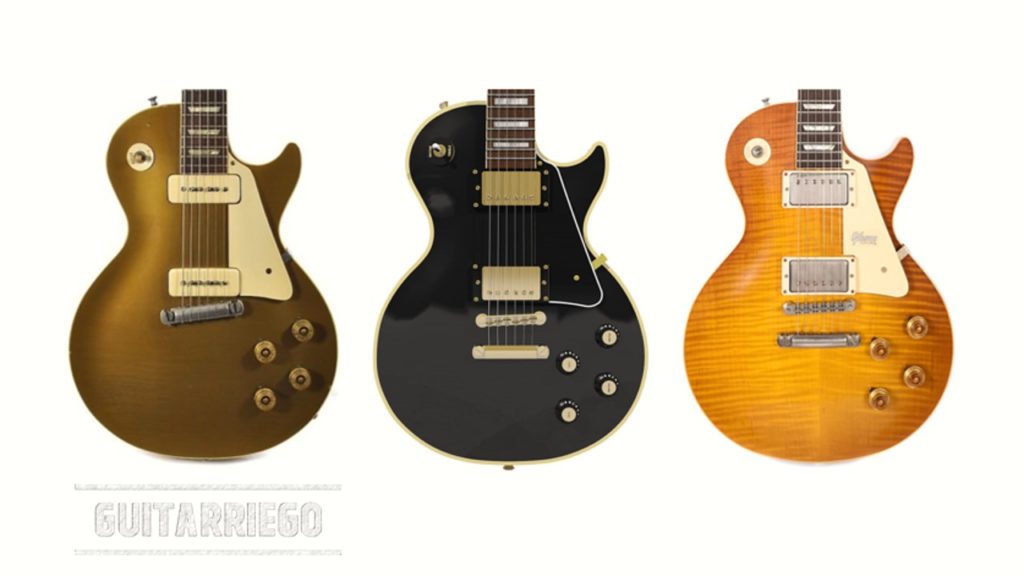
Gibson Les Paul, without a doubt the most emblematic guitar of the most traditional manufacturer, both the Standard and Custom model versions, its evolution and transformation, its golden and black times or eras, and more.
History of the Gibson Les Paul: Appearance, evolution and transformation
The history of the Gibson Les Paul, the first solid-body guitar from the most traditional guitar company, begins in the early 1950s, when the company was led by none other than Ted McCarty, in its golden age.
The Gibson Les Paul was born as McCarty‘s response to the growing popularity and success of his nemesis, the Fender Broadcaster, which later after going through a brief period without a name or “Nocaster” would be called definitively as Telecaster.

Ted McCarty was an engineer with experience and commercial vision, he did not hesitate for a second to realize that the solid guitar business niche that Fender had begun to exploit was a market with great potential. Thus, Gibson decided to compete, designing his own solid body guitar and hiring Les Paul to give him his name and be the image of his new electric guitar model.
Les Paul had already tried to persuade Gibson to make a solid body guitar years before, even before the Fender Esquire appeared in 1950. He had brought “The Log”, but the company had rejected the musician and his proposal saying it was a broomstick with strings and pickups. Thus, it is that Les Paul is said to have told the directors of Gibson: “If you don’t do something, Fender will rule the world.”

You might be interested in our note on Gibson’s Biggest Failures: Ugly, Weird, and Unknown Guitars.
Gibson Les Paul Goldtop, the first guitar
The first version of Gibson Les Paul: 1952
The first Les Paul guitar released by Gibson was the Gibson Goldtop, which was released in 1952, two years after the release of the first Fender guitar.
Most of features were the same as it is today, but not all of them. The Gibson Les Paul had an evolution throughout its first 7 years of life. Mahogany body and neck with arched maple top on the body and rosewood fingerboard. The glued neck has 22 frets with binding and inlays mother-of-pearl trapezoids. It also had a tensor or adjustable soul.
The controls are independent volume and tone for each pickup and a three-position pickup switch. However, the first version had some different characteristics than the final model of the Gibson Les Paul.
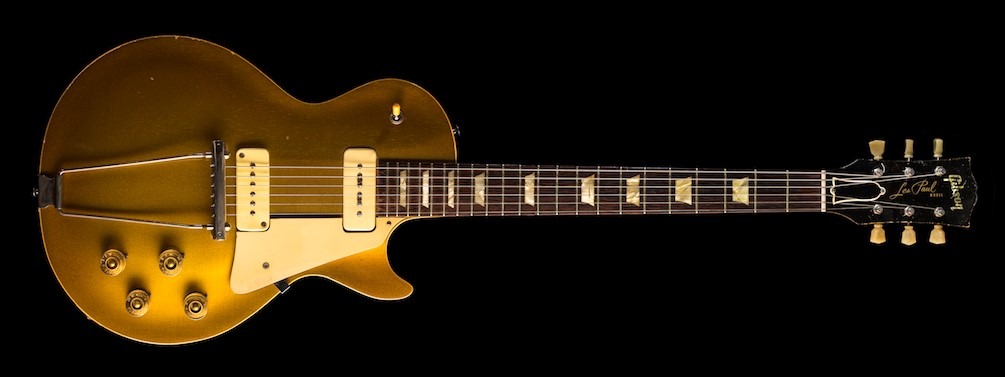
The original Gibson Les Paul ’52 came with P90 pickups, called Soapbar for their aesthetic. These pickups are single coil that Gibson had already invented in 1946.
The traditional long tailpiece and bridge were similar to those used by the brand in the rest of the guitar models such as the Gibson L5 guitar. Les Paul immediately suggested replacing Gibson‘s traditional trapeze tailpiece putting in a solid steel “wrapped around” bar. Ted McCarty has said that this was the guitarist’s only technical input.
The first changes in the evolution of the Gibson Les Paul: 1953 – 1954
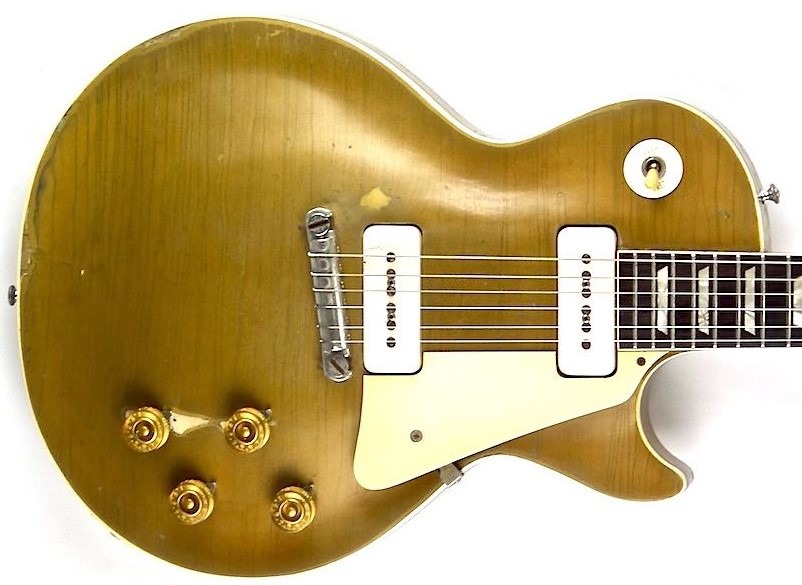
During 1953, the long tailpiece is replaced by the wrapped bridge that Ted McCarty himself designed. Thus, this year you will be able to find guitars with both bridges. The aesthetics of the guitar will be maintained for a couple of years.
The following year, in 1954, another change arrives, the inclination of the mast is also modified with respect to the first model launched on the market. Thus, the mast takes the inclination of 17º, which will be final today. Still mounting P-90 soapbar pickups (single coil) and continuing with the Goldtop finish.
The last and definitive changes of the Gibson Les Paul: 1955 – 1958
In 1954, Ted McCarty invents the Tune-o-Matic bridge, which is incorporated into the new Gibson Les Paul Custom. But it is only in 1955 when the Tune-o-Matic is added to the Gibson Les Paul Goldtop.
This bridge comes with adjustable saddles that allow the guitar to be better calibrated, thus improving tuning. Initially, the tailpiece was thought to be above the tailpiece as in the Wrappover, but finally it is used by putting the strings on the back and making them go directly to the bridge.
In 1957, as a result of the objective of reducing the noise -hum- of the pickups, a Gibson engineer, Seth Lover, designed the double coil pickups known as Humbuckers. The first humbucker pickups are known as P.A.F. or PAF since they had a sticker with the acronym “Patent Applied For” due to Gibson’s patent registration process.

Thus, in 1957 the Les Paul takes the definitive technical specifications that it maintains to this day. However, the following year, in 1958, the finish was changed to the cherry sunburst for which the guitar is best known.
Gibson Les Paul Custom: the deluxe version
In 1954, Ted McCarty searches for an alternative to the Goldtop finish. In that sense Ted has said in an interview: “We added the Les Paul Custom just to have another one. You have all kinds of guitar players who like this and that. Chevrolet has many models, Ford has many models.”

Thus, this black model is launched, with gold hardware and black P90 pickups. In addition, it has a double binding on the body on both sides, on the top and on the back of the body. Also binding on the neck and headstock. In addition, the binding of the blade and the body has a detail of interspersed black and white stripes. Inlays are of the block type, that is, block or rectangular inlays.
Technical differences of the Les Paul Custom with the Standard or Goldtop is that it has a one-piece mahogany body, without a maple top on top. The fretboard is ebony instead of rosewood. Thus, the treble that is given in a Les Paul Standard or Goldtop by the maple top of the body, in a Custom is given by its ebony fretboard. Also, the Custom was the first Les Paul with a Tune-o-Matic bridge, differing from the Goldtop which only adopted it the following year in 1955.
The “Black Beauty”
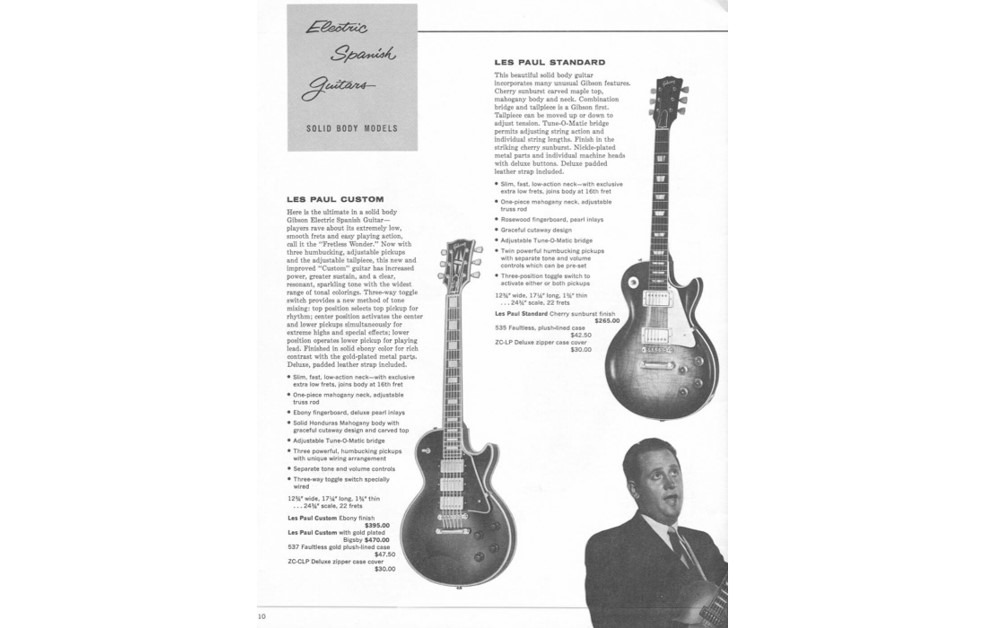
The black beauty or “Black Beauty” is the nickname of the Gibson Les Paul Custom. Black and gold combination is the ideal combination to give status and height to something, that’s why that combination was chosen. Plus there was a good reason to go for a solid color as explained by Ted McCarty:
And there was a good reason for it. We were having more and more trouble getting smooth mahogany from Honduras very well. So if you had a mahogany with some scratches, it was used to make Customs. They were prepared elegantly with binging and other things, and sold at a higher price.»
Thus, mahogany with cosmetic imperfections was used for Les Paul Customs that were painted a solid black color.
Les Paul Custom and the PAFs: 1957
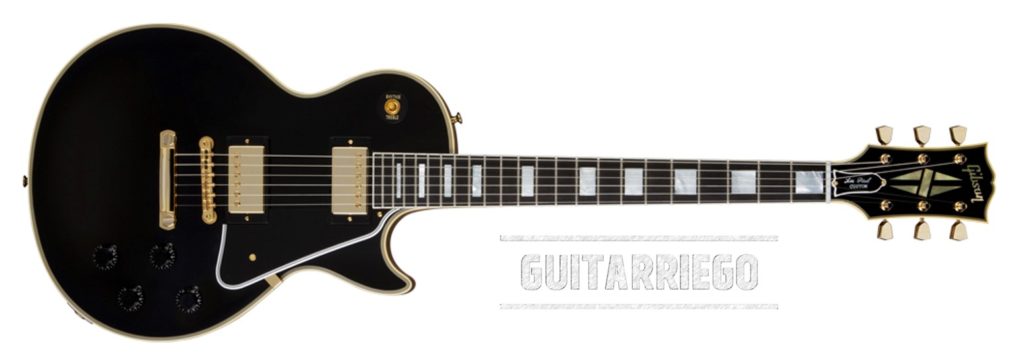
In 1957, like the Gibson Les Paul Goldtop, the Custom adopts PAF pickups. Thus, the final model of the Les Paul Custom is defined. Unless we consider the replacement of ebony by richlite around 2012, which was due to problems of supplying quality wood in sufficient quantity. Richlite is a synthetic material that mimics the aesthetics of ebony.
You may be interested in our Gibson Les Paul vs Epiphone Les Paul comparison: features and differences.
Gibson Les Paul Standard: 1958 – 1960: The Ultimate Makeover

In 1958 the Gibson Les Paul Standard was released with the classic and traditional cherry sunburst finish for which the model is best known. This is the Gibson Les Paul guitar, it is the greatest reference of all, the maximum expression of the evolution of the model. These guitars are called “Burst” because of their finish.
The differences in the specifications of the guitar from these three years are subtle; for example the neck profile is thicker in 1958 and thinner in 1960; in 1958 the maple tops were smoother and the ’59 ones the most flamed. However, Gibson Les Paul 1959 guitars are considered the “Holy Grail” of the model. Thus, the year 1959 is considered the best year of the Gibson Les Paul.

Discontinuation of the Gibson Les Paul
In 1960, the Gibson Les Paul weight was excessive and traditional shape were seen as old-fashioned and expensive. Compared to other existing markets such as the Stratocaster, Jazzmaster, Flying V, Explorer, among others, the Les Paul had lost popularity. Thus the Les Paul is replaced by what was introduced as its successor, the Gibson SG.
The SG was initially released under the name of Gibson Les Paul, and later with the breaking of the contract with Les Paul it would take the name of SG from Solid Guitar. It would be only in 1968 that the construction of the Gibson Les Paul was resumed.
Demo video of several vintage Les Pauls on a 1959 Fender Bassman
If you want to know more about the history of the guitar: from classical to electric guitar.
You can share opinions or also chat about this and more with other musicians in our comments section.






